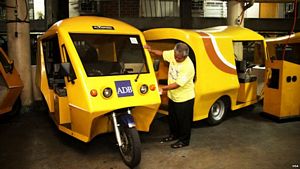|
By accessing/using The Crittenden Automotive Library/CarsAndRacingStuff.com, you signify your agreement with the Terms of Use on our Legal Information page. Our Privacy Policy is also available there. |

Electronic Tricycles Aim to Reduce Pollution in Philippines
|
|---|
|
|
Electronic Tricycles Aim to Reduce Pollution in Philippines
Simone Orendain, VOA News
19 December 2012 (1:55AM)
 The Philippines will build an electric vehicle industry using a $300 million ADB loan, reducing carbon dioxide emissions by 260,000 tons and doubling incomes for tricycle drivers. (Courtesy - Asian Development Bank) The Philippines will build an electric vehicle industry using a $300 million ADB loan, reducing carbon dioxide emissions by 260,000 tons and doubling incomes for tricycle drivers. (Courtesy - Asian Development Bank)
|
MANILA — In the Philippines, the Asian Development Bank has finalized a $300-million loan to partially fund a nationwide electronic vehicle program that will be part of the mass transportation system. The goal is to have 100,000 electronic tricycles plying the country’s streets by 2017 in hopes of making a dent in significant pollution caused by regular tricycles.
The tricycles are ubiquitous, gas-burning motorcycles with two-seater sidecars. Getting the actual electronic tricycles on the ground is taking some time.
Alfredo Forelo turns a key and starts the electronic tricycle- or e-trike. There is no distinct sound of an engine firing up, just lots of noise from passing motorcycles and other vehicles.
Forelo tells Charlie Antiga, an engineer with the Mandaluyong City government, that this e-trike has one hour’s worth of recharging. This means it will be good to run for the next five or six hours.
Forelo pays $1.25 to charge the e-trike. That is significantly less than the $3-$4 he used to spend on gasoline daily driving a conventional tricycle.
He says he saves enough to pay for food, water and electricity
Tricycle drivers typically lease their vehicles for about $4 a day from operators. In Forelo’s case, Mandaluyong City is leasing out his trike. After paying the lease- and recharging fees, he says he earns about $17 a day driving an e-trike. That is more than double the average daily earning of a conventional tricycle driver.
With the motorcycle in front, acting as a towing vehicle for two rows of four-seater benches behind, all under a lightweight yellow shell, the e-trike easily has an advantage on a regular tricycle. Those only seat two, and the driver is only partially shaded from sun and rain.
Mandaluyong, in Manila’s capital region, hired Forelo to drive the e-trike as part of a pilot program. He drives one of the 13 still-functioning e-trikes of the city’s small fleet of 20.
Mandaluyong Tricycle Regulation Office Director Florante de Leon says the Asian Development Bank picked this municipality to test the prototypes because of its commitment to clean-air practices. He says the city will eventually offer a lease-to-own program on the e-trikes, which run about $5,000, as opposed to $3,000 for a regular one.
“There are many applicants here… they want to reserve a unit… because our mayor ordered 400 units of this in the future,” he said.
But De Leon says, judging from the long wait on the repair of some sidelined e-trikes, there is just a 50-50 chance the 400 will come any time soon.
Asia Development Bank Principal Energy Specialist Sohail Hasnie says no company in the world has e-trikes ready to order.
“When you just say that ‘I want to buy,' in a public bidding process, a transparent process, 5,000 trikes from a factory that doesn’t exist today, specification that doesn’t exist today, design that doesn’t exist today, it takes a lot of time to put those things together,” Hasnie said.
According to De Leon, waiting for parts is also taking time. The prototypes were assembled in the Philippines and their main components; the motor, lithium-ion battery and controller, were imported. Officials say the country still does not have the capacity to make those technology-based parts. In Mandaluyong, controllers of seven test e-trikes malfunctioned in March, rendering them useless.
“We cannot repair it. They are now here in the garage, we cannot replace the controller,” he said.
The bank is seeking a combination of car manufacturer, lithium-ion battery maker and motorcycle maker to come up with an e-trike model that suits its requirements. According to Hasnie, after the experience in Mandaluyong the makers of parts must fully guarantee their replacement. And, all parts must be up to the bank’s tough standards so that they function properly for several years.
The $500 million project, funded by the ADB, the World Bank’s Clean Technology Fund and the Philippine government, is now being bid out. Hasnie says, once the order for the first 2,000 arrives in the Philippines, the rest will come more quickly.

















